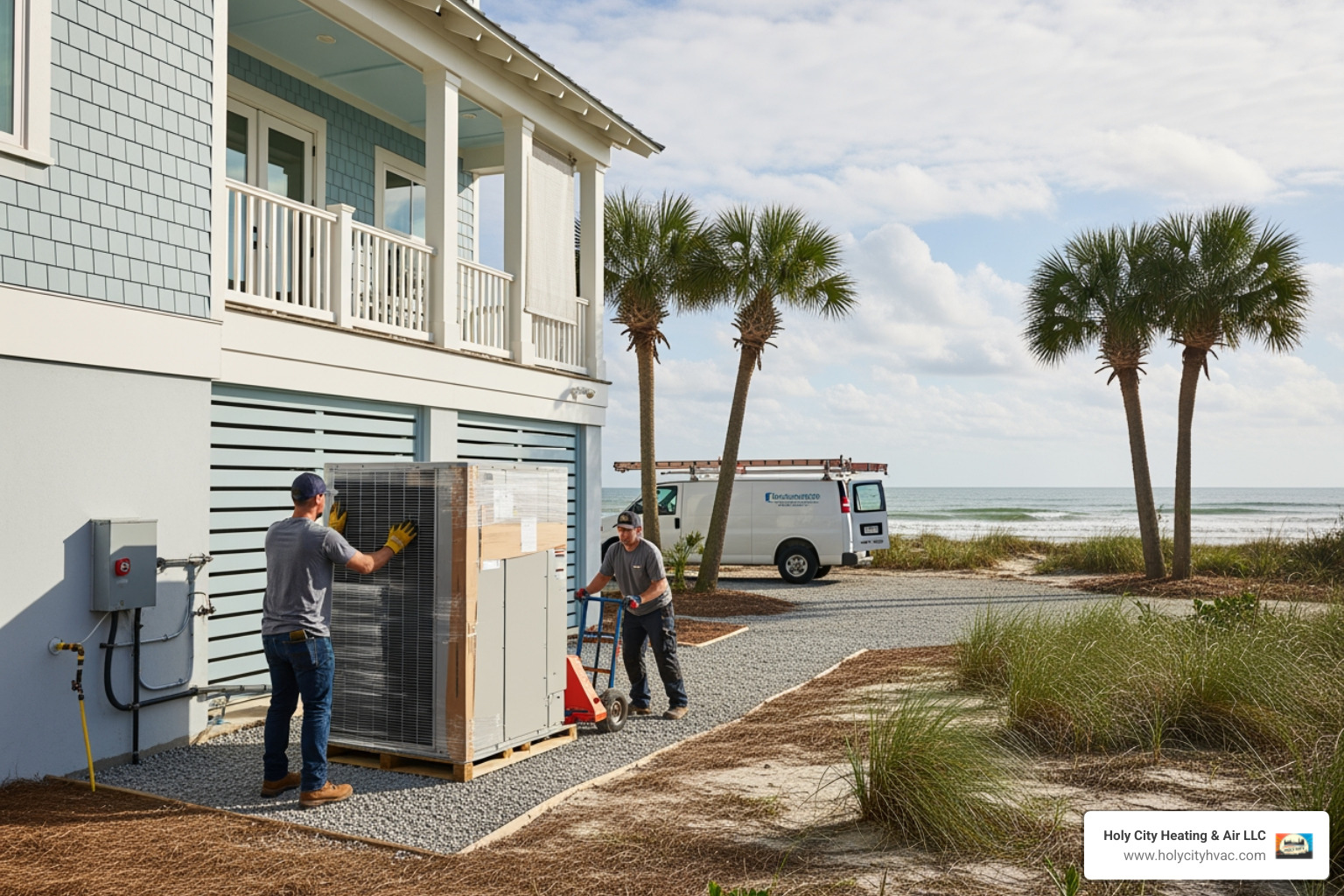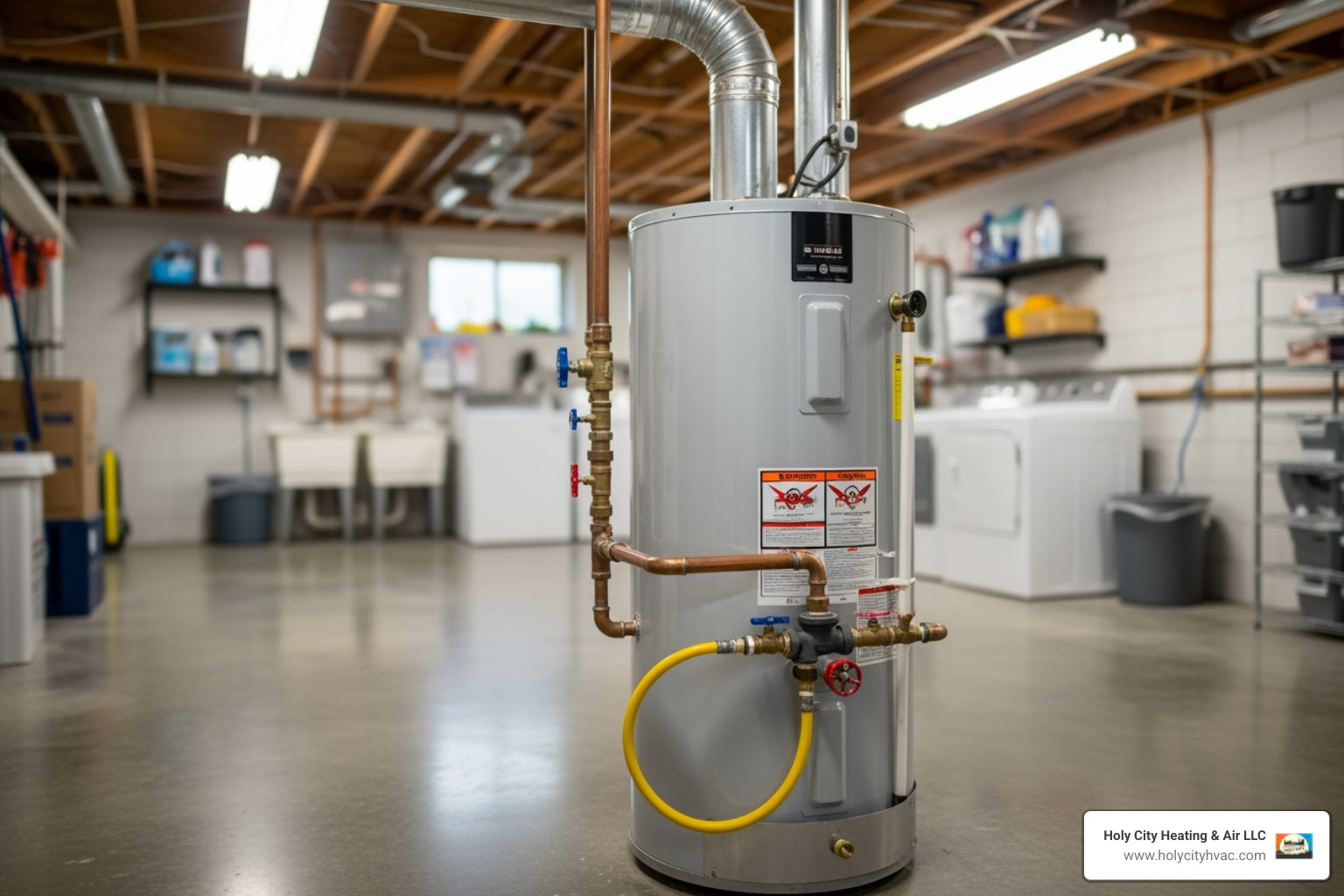
Why Understanding Gas Heater Basics Can Save You Time and Money
When your heating system fails, calling gas heater fixers is the solution. However, many homeowners can solve simple issues themselves. Understanding your gas heater's warning signs and basic troubleshooting can help you know when to call for help versus when it's a simple fix you can handle.
Quick Reference: When to DIY vs. Call Gas Heater Fixers
| DIY First | Call Professionals Immediately |
|---|---|
| Check thermostat settings | Smell gas/rotten egg odor |
| Replace air filter | Yellow pilot light flames |
| Reset circuit breaker | Strange banging or booming sounds |
| Change thermostat batteries | No heat after basic checks |
| Clear blocked vents | Water leaks around unit |
Most heater issues stem from overuse, worn parts, or dirty air filters that restrict airflow. Simple maintenance like changing filters and checking thermostat batteries can prevent many service calls.
However, safety is paramount. Gas appliances should be serviced by qualified technicians to prevent carbon monoxide risks and maintain warranty coverage.
When your heater stops working on a chilly Charleston night, knowing what to check first can restore comfort quickly. This guide covers safe DIY troubleshooting and clarifies when to call professional gas heater fixers.
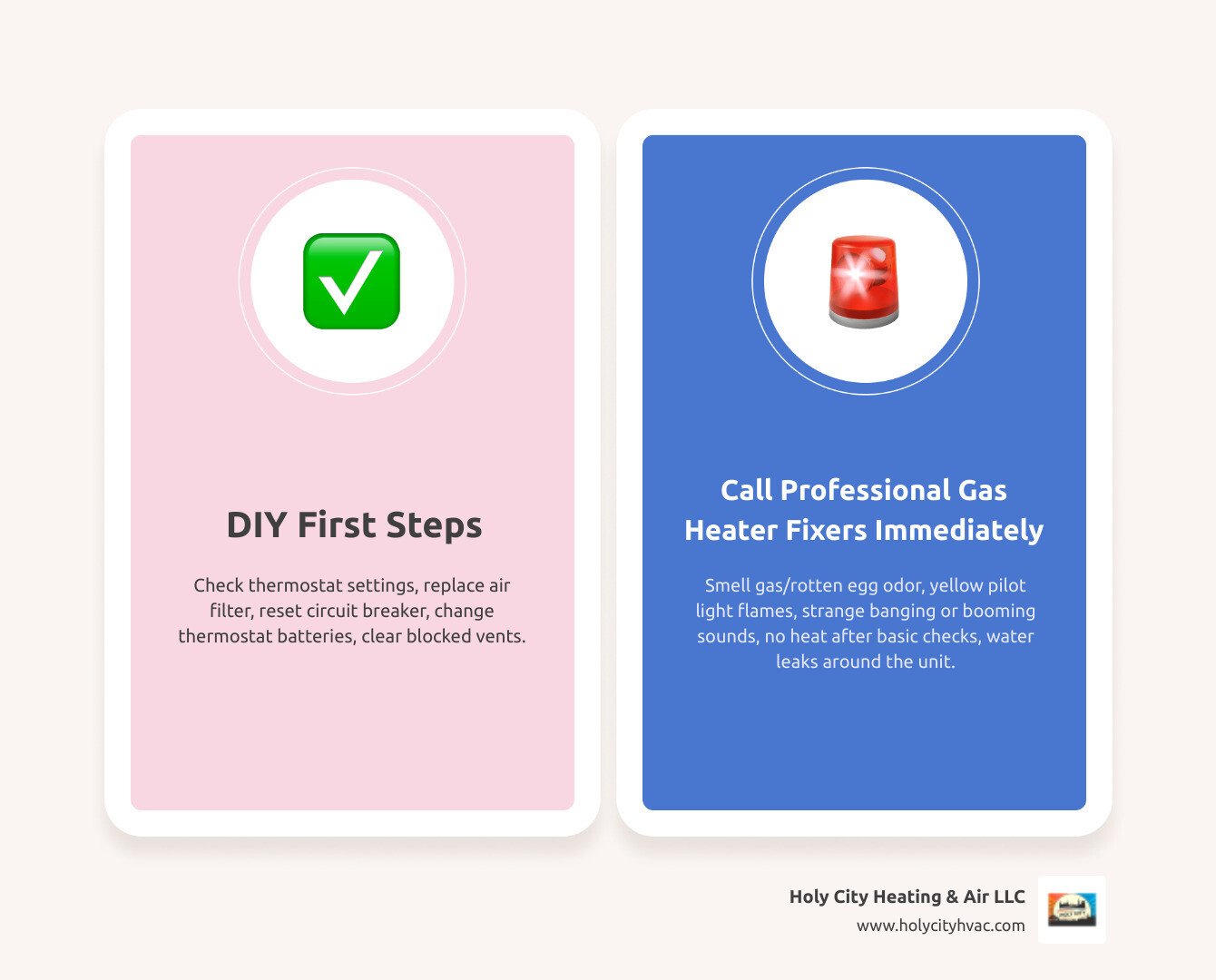
Understanding Your Gas Heater: Key Components and How They Work
Think of your gas heater as the heart of your home's comfort system. Understanding how it works can help you spot problems early and know when to call gas heater fixers.
Most homes use a gas furnace with a forced-air system. The furnace burns natural gas or propane, and a blower distributes the heat. The process starts when your thermostat signals for heat. Gas flows to the burners and is lit by an ignitor or pilot light. The flames heat the heat exchanger, a crucial component that keeps combustion gases separate from your breathing air. The blower motor then pushes air across the hot exchanger and through your vents and ductwork.
Safety devices like the flame sensor monitor the system, shutting it down if a problem is detected. For more details on recognizing when this complex system needs attention, check out our guide on How to Know When Your Furnace Needs Repair.
Types of Gas Heaters Common in Homes
Knowing your heater type helps when talking with gas heater fixers.
- Central furnaces are the most common in Charleston. Located in a utility room, basement, or attic, they use ductwork to heat the entire home and often share it with the AC system.
- Wall-mounted gas furnaces heat specific zones or rooms. They mount on an exterior wall and vent directly outside, making them simpler to install but with limited capacity.
- Ducted gas heating systems is the term for the complete setup: furnace, ductwork, and vents working together for whole-house heating.
How a Gas Heater Creates Warmth
The process is a clever cycle of heat generation and distribution.
- Combustion: Gas and air mix at the burners, creating controlled flames.
- Heat Exchange: Hot combustion gases heat the metal heat exchanger. This heat is then transferred to your home's air without the gases ever mixing.
- Air Circulation: The blower motor pushes cool air over the hot exchanger, warming it before sending it through your ducts.
- Exhaust Venting: Harmful combustion byproducts like carbon monoxide are safely vented outside through a flue pipe.
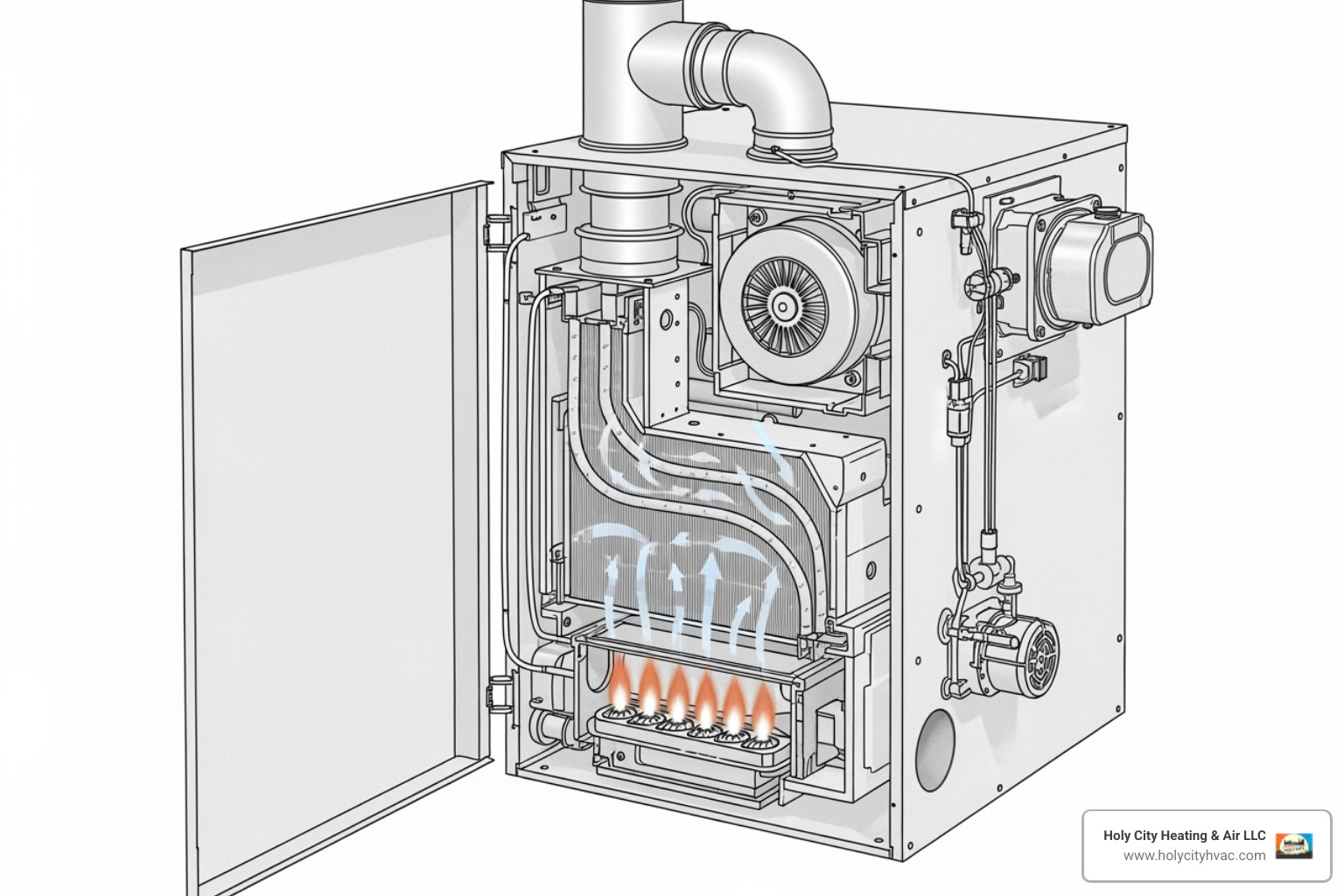
Telltale Signs Your Gas Heater Needs Attention
Your gas heater usually gives clear hints when it needs help. Recognizing these warning signs can prevent a cold night and more expensive repairs.
- Strange Noises: Your furnace should hum quietly. A loud booming on startup suggests a dangerous gas buildup. Rattling could mean a loose panel or failing blower component, while squealing points to motor or bearing issues.
- Unusual Smells: A rotten egg smell indicates a gas leak and requires immediate evacuation and a call for help. A brief burning dust smell is normal at the start of the season, but a persistent metallic or electrical odor signals overheating parts.
- Inconsistent Heating: If some rooms are hot and others are cold, you have cold spots that may point to blower or ductwork problems. Short cycling (when the heater turns on and off too frequently) puts excessive stress on the system.
- Rising Energy Bills: If your utility costs are climbing, your heater may be losing efficiency and needs a professional check-up. For more warning signs, see our guide on 5 Signs That Your Furnace Needs Help.
Visual and Auditory Warning Signs
Some signs are urgent and require immediate attention from professional gas heater fixers. Never ignore these 5 critical indicators:
- A Yellow Pilot Light: A pilot light should be blue. A yellow or flickering flame indicates incomplete combustion, which can produce deadly carbon monoxide.
- Soot Around the Unit: Black soot marks around the furnace are another red flag for incomplete combustion and carbon monoxide risk.
- Water Leaks: Puddles around your furnace could be a simple clogged drain line or a much more serious cracked heat exchanger.
- Loud Bangs on Startup: A boom when the furnace ignites suggests delayed ignition, where gas accumulates before lighting. This is dangerous and can damage your system. We've written about this: Have a Booming Furnace? It's Time to Call Us.
- Carbon Monoxide Detector Alarms: If your CO detector goes off, evacuate your home immediately and call 911 or your gas company from a safe location. This is the most critical warning of all.
These signs indicate a potential safety risk. Contact professional gas heater fixers right away.
Your Pre-Call Checklist: Simple DIY Troubleshooting Steps
Before calling gas heater fixers, a few simple checks might solve the problem and save you a service call. Think of it as your system's version of "turning it off and on again."
Safety first. Before any inspection, turn off the power to your furnace at the circuit breaker. If you suspect a gas issue, also turn off the gas supply valve, located on the line leading to your unit.
Now, follow this pre-call checklist:
- Check the Thermostat: Ensure it's set to "Heat" and the temperature is set higher than the current room temperature. Also, confirm the fan is on "Auto," not "On."
- Change Thermostat Batteries: Dying batteries in a digital thermostat can cause it to malfunction. This is a quick and common fix.
- Inspect the Air Filter: A clogged filter can cause your furnace to overheat and shut down. If you can't see light through it, replace it.
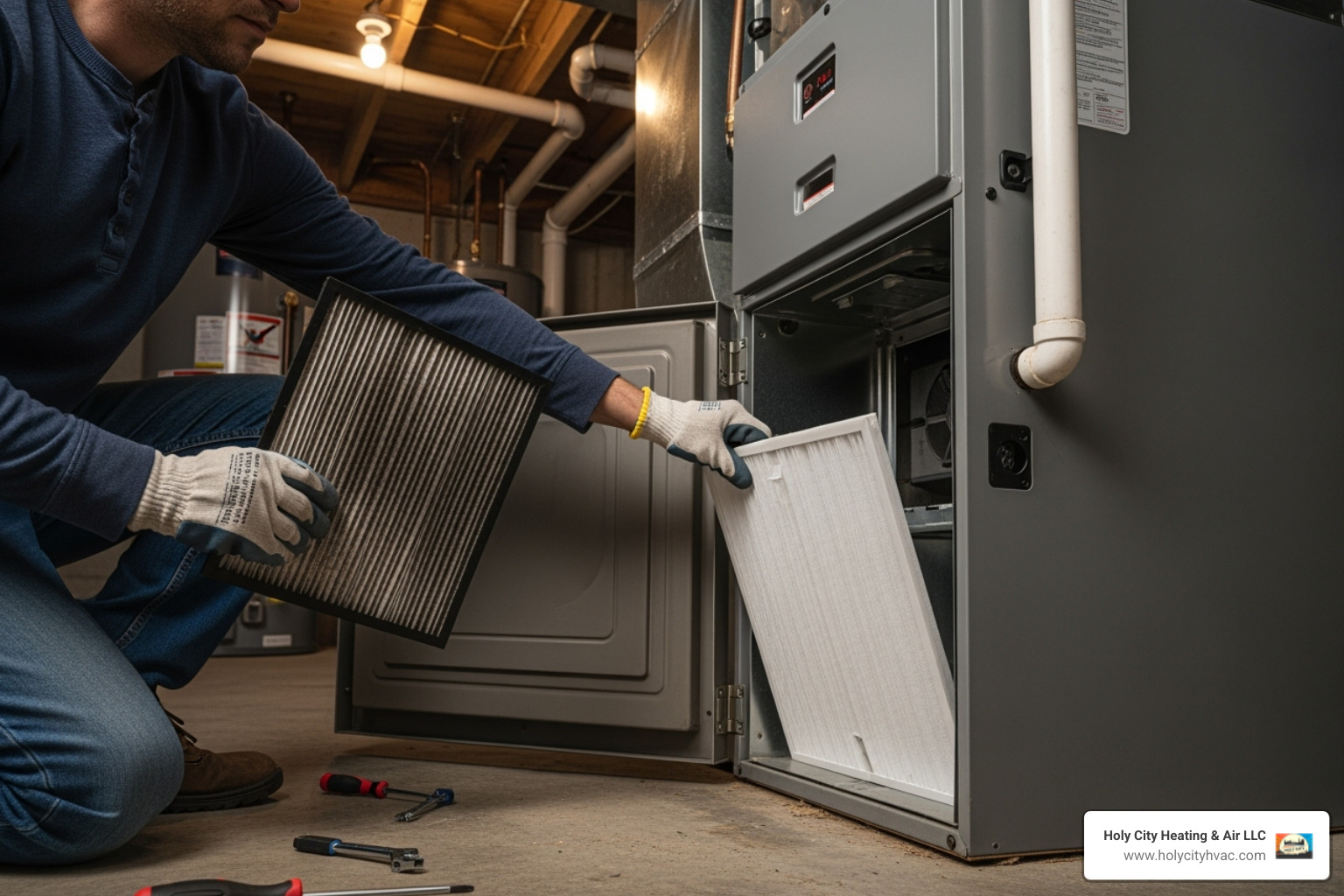
- Check the Circuit Breaker: Find the breaker labeled "Furnace" or "HVAC." If it's tripped, flip it fully to "Off," then back to "On." If it trips again, there's an electrical issue that needs a professional.
- Ensure Gas Valve is Open: The handle on the gas valve should be parallel to the pipe. If it's perpendicular, it's closed.
- Inspect for Blocked Vents: Make sure furniture, rugs, or curtains aren't covering supply or return air vents. Proper airflow is essential.
These checks solve many common heating problems. For more tips, see our guide on Maintenance Tips for Your Furnace.
If you've run through this list and still have no heat, it's time to call professional gas heater fixers.
When to Call Professional Gas Heater Fixers
While DIY fixes are great, some situations demand a professional. Knowing when to call gas heater fixers is crucial for your safety.
Call a professional immediately if you encounter these issues:
- Gas Smell: If you smell gas or rotten eggs, evacuate everyone from the house immediately. Do not use phones or light switches inside. Once safe, call 911 or your gas company.
- Major Mechanical Failures: If your heater still won't work after basic troubleshooting, the problem is likely a failed ignitor, blower motor, or other complex component that requires expert diagnosis.
- Electrical Problems: A circuit breaker that repeatedly trips or a persistent electrical smell indicates a fire hazard that only a trained technician should handle.
- Cracked Heat Exchanger Signs: A yellow pilot light or soot buildup can signal a cracked heat exchanger, which could leak carbon monoxide into your home.
- Carbon Monoxide Alarms: If your CO detector goes off, treat it as an emergency. Evacuate and call for help. A professional inspection is needed before it's safe to return. For more on issues requiring a pro, see our guide on Common Furnace Repair Issues.
The Dangers of DIY: Why Some Jobs Are for Professional Gas Heater Fixers
Enthusiasm for DIY is great, but with gas heaters, it can be dangerous. Some repairs are not worth the risk.
- Carbon Monoxide Poisoning: Incorrect repairs can cause leaks of this colorless, odorless gas. Professionals have the equipment to detect and prevent this silent threat. Learn more about the dangers from the U.S. Environmental Protection Agency.
- Gas Leaks and Fire Risks: Working with gas lines without proper training is extremely hazardous. A small mistake can lead to a gas leak, creating a risk of fire or explosion.
- Voiding Warranties: Most manufacturers require repairs to be done by certified professionals to keep your warranty valid.
- Causing More Damage: A DIY attempt can turn a minor issue into a major, expensive repair. Avoid these pitfalls by reading about Furnace Repair Mistakes to Avoid.
What to Expect During a Professional Service Call
When you call Holy City Heating & Air, you can expect a smooth, transparent process.
- System Diagnosis: Our technician will use specialized tools to accurately identify the root cause of the problem.
- Clear Explanation: We'll explain the issue in plain English, so you understand what's wrong and what's needed to fix it.
- Repair Process: We'll outline the repair plan and timeline. Our trucks are well-stocked to complete most repairs on the first visit.
- Final Safety Testing: After the repair, we conduct rigorous safety checks for gas leaks and carbon monoxide to ensure your system is operating safely.
To prepare, please clear the area around your furnace. For more tips, see our guide on Heating Repair Tips from Our Experts.
Prevention is the Best Fix: Maintenance and Lifespan
Regular maintenance is the best way to avoid emergency calls to gas heater fixers. Think of it like a regular check-up for your car—it keeps things running smoothly and extends its life.
As a homeowner, your main job is to check and replace your air filter regularly (every 1-3 months). This simple task prevents airflow issues and keeps your system from overworking. Also, ensure your vents and return air grilles are not blocked by furniture or rugs.
While these basics help, professional annual tune-ups are essential. A certified technician will inspect gas connections, check the heat exchanger for cracks, clean burners, test safety controls, and measure carbon monoxide levels. These yearly visits are often required to keep your manufacturer's warranty valid and are crucial for preventing major breakdowns. Our guide on why Furnace Needs Regular Maintenance explains this in more detail.
With proper care, a gas furnace can last 15 to 25 years. Regular maintenance is key to reaching that lifespan and, more importantly, protecting your family from carbon monoxide risks. Always have working carbon monoxide detectors in your home.
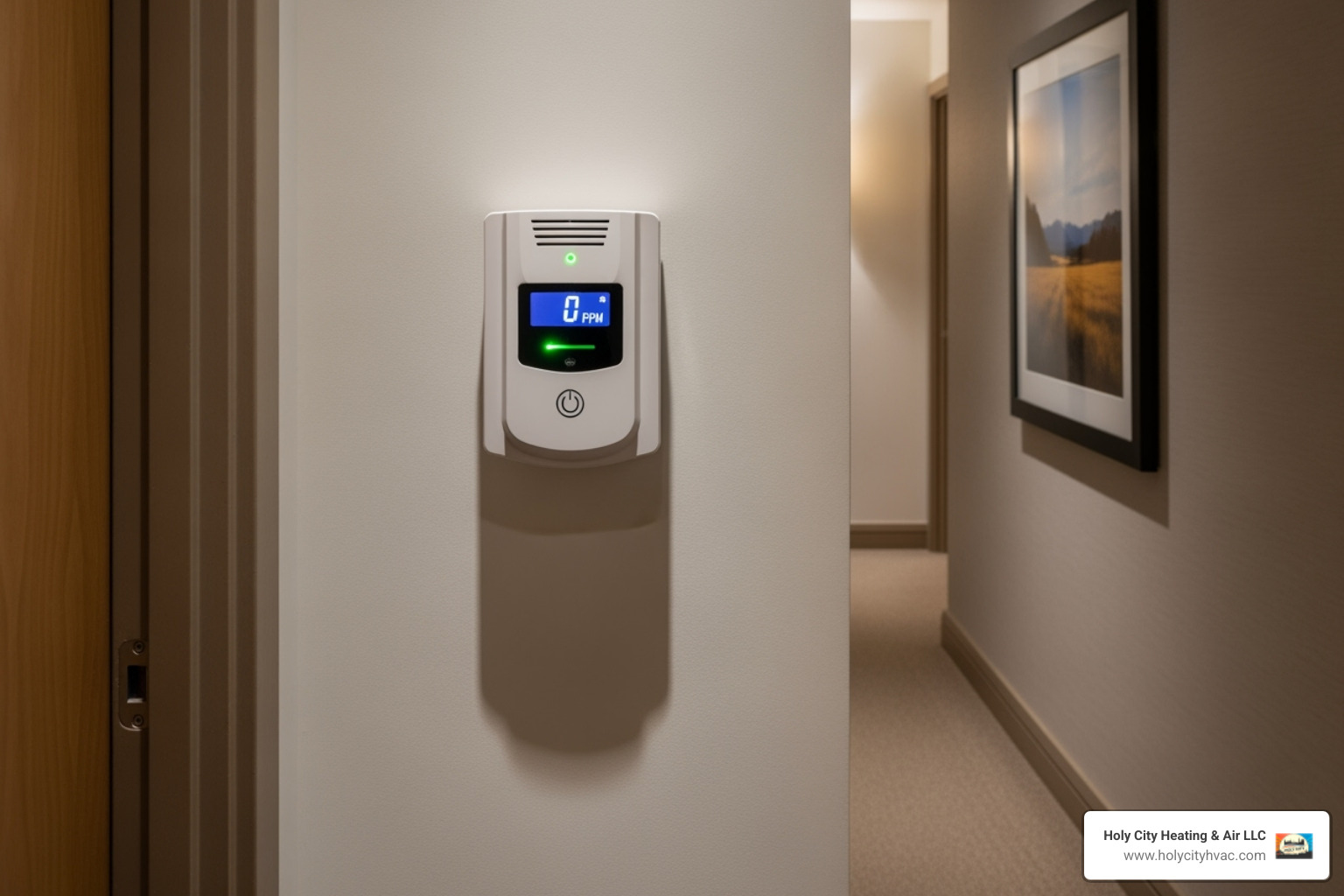
Deciding to Repair or Replace Your Gas Heater
Eventually, you'll face the repair vs. replace decision. Here are the key factors to consider:
- Age: If your furnace is over 15 years old, it's approaching the end of its expected lifespan. Replacement becomes a more cost-effective option.
- Frequency of Repairs: Are you constantly calling gas heater fixers? If repair bills are piling up, investing that money in a new system makes more sense.
- Energy Efficiency: Modern furnaces are far more efficient than older models. A new unit can significantly lower your energy bills, helping to offset the initial investment.
Our team can help you weigh the options. For a deeper dive, read our article: Do You Need a Heater Repair or Replacement?
Frequently Asked Questions About Gas Heater Problems
As gas heater fixers in the Charleston area, we hear many of the same questions from homeowners. Here are answers to the most common ones.
Why is my heater blowing cold air?
This is a frustrating but common issue. Here are the most likely causes:
- Incorrect Thermostat Settings: First, check that your thermostat is set to "Heat" and the fan is on "Auto."
- Clogged Air Filter: A dirty filter can cause the furnace to overheat and shut down the burners, while the fan continues to blow unheated air.
- Pilot Light/Ignitor Issue: An extinguished pilot light (on older units) or a faulty ignitor (on newer ones) means there's no flame to produce heat.
- Clogged Condensate Line: On high-efficiency furnaces, a blocked drain line can trigger a safety switch that shuts off the heat.
If these simple checks don't solve the problem, it's time to call a professional. For more troubleshooting ideas, see our Heating Repair Tips for Common Issues.
What does a yellow pilot light on a gas heater mean?
A yellow pilot light is a serious safety warning that requires immediate attention from gas heater fixers. A healthy pilot light is a steady blue flame.
A yellow flame indicates incomplete combustion, which means the gas isn't burning correctly. This can be caused by a dirty burner and can produce dangerous carbon monoxide.
If you see a yellow pilot light, turn off your furnace and call us immediately. Do not attempt to clean the burner yourself. This issue requires professional inspection to ensure your system is safe. Learn more about critical warnings in our guide on Signs Your Heating System Needs Immediate Repair.
How often should I have my gas heater serviced by professional gas heater fixers?
We recommend annual professional servicing for your gas heater, ideally before the heating season begins. This is crucial for several reasons:
- Safety: A technician will check for gas leaks, cracks in the heat exchanger, and carbon monoxide levels.
- Efficiency: A tune-up ensures your furnace runs efficiently, which can lower your energy bills.
- Warranty: Most manufacturers require annual service to keep your warranty valid.
- Longevity: Regular maintenance prevents small issues from becoming major, expensive repairs, extending the life of your system.
An annual tune-up is a small investment in your comfort, safety, and peace of mind. Our Heating Repair Checklist can help you prepare for a service visit.
Stay Warm and Safe This Winter
You are now equipped to handle minor heating issues and, more importantly, to recognize when to call professional gas heater fixers.
Remember the basic troubleshooting steps: check your thermostat, air filter, and circuit breaker. These simple actions can often restore your heat without a service call.
However, safety is paramount. If you smell gas, see a yellow pilot light, or your carbon monoxide detector goes off, evacuate immediately and call for help. Your family's safety is not worth a DIY risk.
The value of professional service comes from specialized training, proper tools, and a commitment to safety. When you call Holy City Heating & Air, you get peace of mind knowing the job is done right.
As a trusted part of the Charleston community since 2015, we're here to help with any heating issue, from strange noises to annual maintenance.
For reliable and safe gas heater repairs in the Charleston area, trust the certified professionals at Holy City Heating & Air. Contact us today for all your heating service needs and stay warm and safe this winter.
Recent posts






